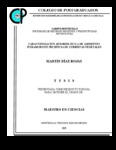| dc.contributor.author | Díaz Rojas, Martín | es |
| dc.date.accessioned | 2012-09-08T03:46:53Z | |
| dc.date.available | 2012-09-08T03:46:53Z | |
| dc.date.issued | 2008 | es |
| dc.identifier.uri | http://hdl.handle.net/10521/1176 | |
| dc.description | Tesis ( Maestría en Ciencias, especialista en Fruticultura).- Colegio de Postgraduados, 2008. | es |
| dc.description.abstract | La contaminación del aire en espacios de intramuros es considerada como una amenaza para la salud. Recientes estudios han demostrado que una variedad de plantas de interior pueden remover diversos contaminantes del aire. Ante esta problemática, es importante conocer el tipo y concentración de esporas fúngicas dispersas en el aire, responsables de enfermedades en el hombre y la influencia que pueden tener las plantas en áreas de intramuro. Se muestrearon
esporas de hongos aéreas en 3 oficinas ubicadas en el edificio de documentación y biblioteca del Colegio de Postgraduados Campus Montecillo, México. Dos etapas se contemplaron: la primera sin plantas y la segunda con plantas. El trabajo de campo se realizó durante tres semanas del 12 al 16 de marzo; 16 al 20 de abril y del 14 al 18 de mayo del 2007. Los parámetros ambientales de temperatura y luz se registraron con un data logger serie Pendant® (Onset© Co.) y las muestras de esporas fúngicas con un impactador de partículas de una etapa Andersen (Thermo Electron Corporation®) durante 15 min, en agar papa dextrosa (PDA) por duplicado. La identificación de los hongos fue a nivel de género. Los géneros que predominaron fueron Alternaria, Cladosporium, Epiccocum, Fusarium y Penicillium. Sin embargo, también estuvieron presentes especies de Aspergillus niger y Aspergillus candidus. Con presencia de plantas los niveles de
esporas aéreas disminuyeron por arriba del 60% y la temperatura ambiente aumentó entre 2 y 3 °C en las tres habitaciones. En cuanto a la intensidad luminosa no se observaron diferencias significativas ante la presencia de plantas. Se observó, un claro comportamiento entre la
intensidad de luz y la posición de las áreas intramuro. El análisis de correlación de Pearson mostró que existe relación significativa entre el número de colonias de hongos con respecto a la temperatura y la presencia de plantas. Se sugiere considerar la existencia de un efecto sinérgico entre las plantas y la temperatura con respecto a la concentración fúngica. Esto es importante ya que las plantas pueden ayudar a incrementar la calidad del aire en espacios intramuros._______Indoor air pollution is considered a health risk by many experts. Recent investigations have shown that a great variety of indoor plants are able to remove many pollutants from the air. It is
important to know the type and concentration of the aerial fungal spores responsible for many respiratory diseases in man and the influence that plants can have in an indoor environment. Aerial fungal spores were collected from three offices in the library located at the Colegio de Postgraduados Campus Montecillo, Mexico. In this study two stages were followed: one with plants and another without them. The field work was done during three weeks from March 12th to the 16th, April 16th to the 20th, and from May 14th to the 18th, 2007. Environmental parameters such as temperature and light were registered for each area using a data logger Pendant™ series
(Onset© Co.) and fungal spore samples using an one-stage Andersen particle sampler (Thermo Electron Corporation™) in a 15 min period, in potato dextrose agar (PDA) for duplicate. Fungal identification was done to the genus level. Cladosporium, Epiccocum, Fusarium and Penicillium were the predominant genera obtained; although Aspergillus niger and A. candidus were also found. Aerial spore levels decreased 60% in the presence of plants as temperature increased
between 2°C and 3°C in the three rooms sampled. No significant differences for light intensity were observed when there were plants present. There was a clear behavioral relation between the intensity of light and the position of the indoor environments. Pearson’s correlation analysis showed that there was a significant relationship between the number of fungal colonies and temperature with plants present. It is suggested to consider the existence of a synergistic effect between plants and temperature regarding the fungal concentration. This is important because plants can help improve the air quality in indoor spaces. | es |
| dc.description.sponsorship | CONACYT | es |
| dc.language.iso | Spanish | es |
| dc.language.iso | spa | es |
| dc.subject | | es |
| dc.subject.ddc | Contaminación | |
| dc.subject.ddc | Aire | |
| dc.subject.ddc | Ornamentales | |
| dc.subject.ddc | Deuteromicetos | |
| dc.subject.ddc | Andersen | |
| dc.title | Caracterización aerobiológica de ambientes intramuro en presencia de cubiertas vegetales | es |
| dc.type | Tesis | es |
| Tesis.contributor.advisor | Calderón Ezquerro, María del Carmen | es |
| Tesis.contributor.advisor | González Chávez, María del Carmen | es |
| Tesis.contributor.advisor | Vidal Gaona, Guadalupe | es |
| Tesis.contributor.advisor | Gutiérrez Espinosa, Jorge. | es |
| Tesis.contributor.advisor | Gutiérrez Espinosa, Ma. Alejandra | |
| dc.subject.ingles | Pollution | es |
| dc.subject.ingles | Air | |
| dc.subject.ingles | Ornamental | |
| dc.subject.ingles | Deuteromicetos | |

